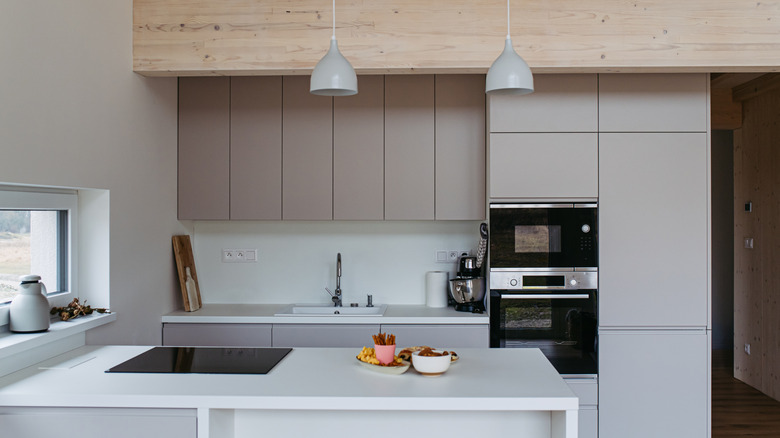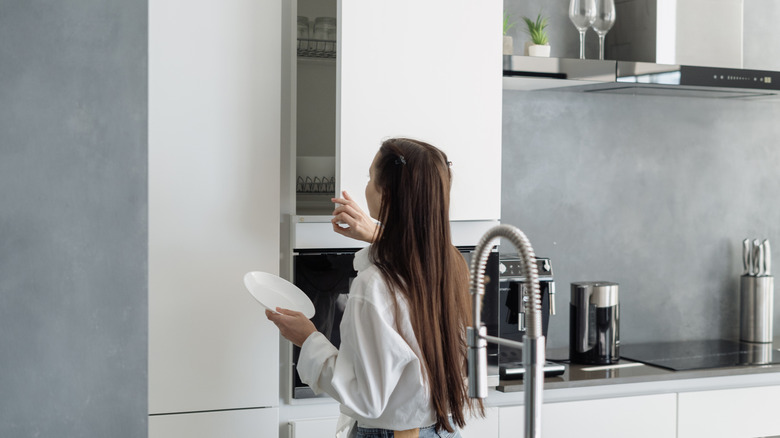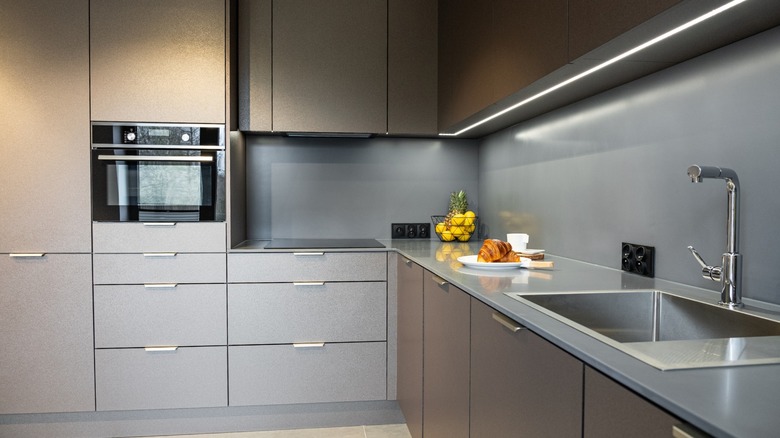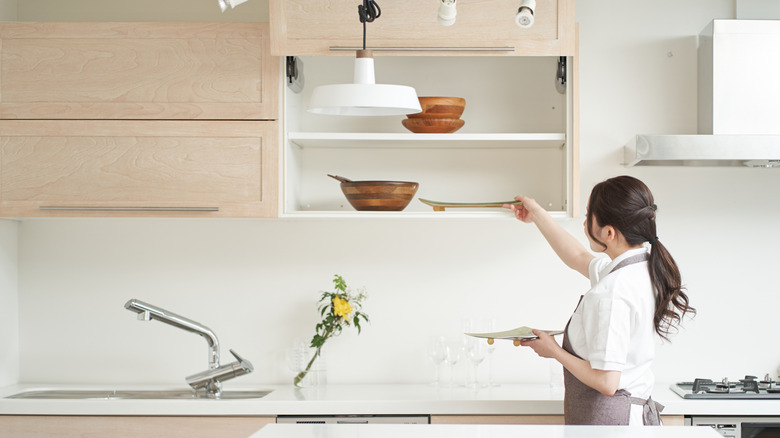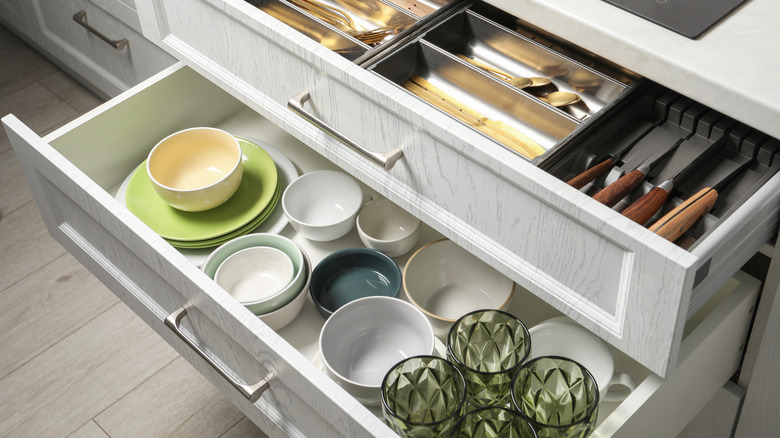The Hidden Downsides Of Ultra-Minimalist Kitchens
If you've been feeling overwhelmed by the clutter in your kitchen and looking for ways to turn your crowded kitchen into a minimalist space, you're not alone. The seamless cabinets, clean lines, and the calming feeling of a clutter-free space make ultra-minimalist kitchens so appealing, which explains why they're all over social media and magazine covers. But, be forewarned, there are some hidden downsides that you should take into consideration before you bite the bullet.
While these kitchens may be the epitome of modern sophistication, it's important to know that certain trade-offs might affect how your space feels and functions on a daily. When you opt for an ultra-minimalist kitchen, you're prioritizing style over practicality and simplicity over comfort. Oh, and you'll probably be sacrificing that warm, lived-in ambiance for a polished, unfussy space. Think of a high-end showroom-style one rather than a super homey kitchen feel. Beyond that, maintaining an ultra-minimalist kitchen isn't the easiest task. Imagine the daily upkeep of putting every appliance and gadget away after use so your countertops remain clutter-free.
Lack of warmth
Perhaps the most overlooked drawback of an ultra-minimalist kitchen is the lack of warmth. While kitchens with clear countertops and clean-lined cabinets are always ready for a photo-op, they also have the tendency to look cold. Instead of giving guests a welcoming and inviting feeling, these kitchens may come off like an art gallery — something to admire from afar rather than truly enjoy. With that in mind, you have to ask yourself if that's the kind of vibe you'd like for your kitchen to have. If you're more of an eating-out family and spend little time in the kitchen, then this aesthetic shouldn't be a problem. However, if you love to invite family and friends over for big dinners and barbecues, you might want to rethink an ultra-minimalist kitchen.
There's a reason many people say a kitchen is the heart of the home. It's a space where people come together and share the experience of preparing and enjoying meals together. And while too much clutter can make a kitchen feel frustrating and overwhelming to be in, a kitchen in too pristine of a condition can feel just as uninviting. Household members and guests should be comfortable using the space, but when a kitchen feels overly controlled or too delicate, it discourages people from actually enjoying the space as they're afraid they'll mess it up.
Difficulty showing your personality
If expressing personal style is a priority for you, another hidden downside of ultra-minimalist kitchens worth considering is that there's little room to add personality. When you think of this streamlined aesthetic, neutral colors, sleek surfaces, and pared-down designs often come to mind, which can give the impression of a space that's restrained and impersonal. And while you can add pops of color, unique decor, and personal touches, doing so requires some strategizing (since you won't want to include anything that ruins the ultra-minimalist look).
For instance, you'll need to find pops of color that mesh well with a neutral palette rather than clash with it. If you want to add character, it's best to focus on core materials and finishes, as you won't be able to rely on too many decorative objects. Therefore, injecting personality into an ultra-minimalist kitchen isn't impossible, but you can't really go about it freely either. There are a lot of guidelines and rules you'll have to consider to ensure the space still feels calm and cohesive at the end of the day.
Hard to maintain
Maintenance is another factor you may want to consider when it comes to ultra-minimalist kitchens. The clutter-free look is undeniably beautiful, but keeping it that way requires constant effort — especially if you have kids. With a kitchen being a high-traffic space, you'll always have someone grabbing a snack, leaving something on the counter, and moving items around. So, on top of everything else you already do in the kitchen (like cleaning and cooking), constant tidying will become yet another task on your to-do list.
Once you achieve an ultra-minimalist kitchen style, you probably won't want to see it any other way, which can make even the smallest mess feel stressful and disruptive to the overall design. In an interview with Food52 about their ultra-minimalist kitchen and its upkeep, architect John Pawson and his wife, author Catherine Pawson, conveyed just how much effort goes into maintaining that pristine aesthetic. Catherine shared that when she cooks "it's like a bomb has hit the kitchen," and that she likes to leave the cleaning for last. Meanwhile, John admitted a lot of effort goes into restoring order in the kitchen after they've cooked. While John seems to genuinely enjoy the act of tidying up, it's clear that maintaining the calm, clutter-free look takes some dedication — there simply isn't room for a lazy day.
Strategic storage demands
If you're starting from scratch with absolutely nothing in your kitchen, an ultra-minimalist design scheme might be easier to achieve. But that's rarely ever the case. It's more than likely you've got a lot of kitchen items, from appliances to specialty gadgets and tools. The real question is: Where will all these items go to keep your countertops clear? Unless you're ready to throw everything away, these essentials will need to be carefully organized and concealed in your pantry, cabinets, and drawers. Or, you might even need to consider implementing an appliance garage for less mess.
That's why smart, intentional storage planning is key to pulling off this style successfully. If you're someone who likes to declutter your space often and enjoys organizing, this could definitely feel more rewarding than restrictive. However, for most, it can quickly become an ongoing challenge to maintain, more so if you have a big family. The more people there are means there are usually more plates, bowls, cups, utensils, and even lunch boxes to consider when it comes to storage. You have to ask yourself, "Do I have enough cabinets and drawers to put all of these things away?" If you do, that's great. If not, you're going to have to start planning for extra storage options.
On top of that, with everything put away, it'll be easy to forget where things are. And even when you do know where things are, taking them out, setting them up for use, and then putting everything back all add extra time and effort to your kitchen routine — making the ultra-minimalist kitchen feel less convenient than it looks.
Reduced functionality
A downside of ultra-minimalist kitchens that's often overlooked is reduced functionality in favor of a seamless appearance. It's easy to get caught up in putting everything away and out of sight without considering the importance of kitchen ergonomics in daily kitchen use. As mentioned above, when practical elements and conveniences are hidden to maintain a fuss-free look, accessibility instantly becomes limited.
A kitchen designed just for aesthetics may result in physical strain due to the awkward placement of appliances, storage, and workspaces. To reach things you've put away, you'll likely be doing a lot of bending, reaching, and twisting than what feels natural to your body. Over time, this can lead to posture-related pain and soreness and make everyday tasks feel a bit burdensome. In fact, some people with minimalist kitchens might go so far as to stop using their blender and food processor because retrieving them from a hard-to-reach cabinet is too taxing.
